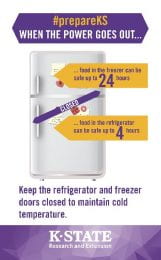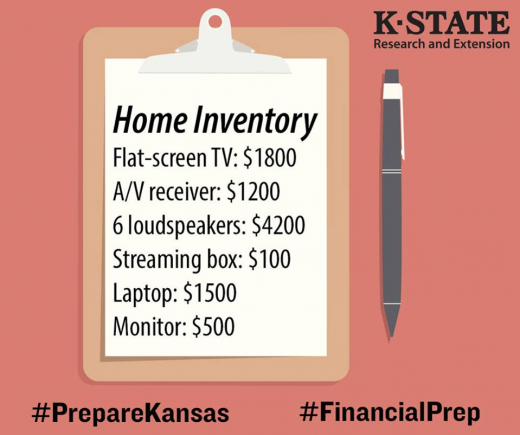 Severe weather events like thunderstorms and tornadoes can bring down power lines in a neighborhood or even entire grids of a city. When the power goes out, the clock starts ticking on the viability of perishable foods in the refrigerator and freezer.
Severe weather events like thunderstorms and tornadoes can bring down power lines in a neighborhood or even entire grids of a city. When the power goes out, the clock starts ticking on the viability of perishable foods in the refrigerator and freezer.
According to the USDA, bacteria like E. coli, Salmonella, and Campylobacter can grow within minutes of food entering the “Danger Zone” – the range of temperatures between 40 and 140 degrees F. The insulation in freezers and refrigerators are your best allies during a power failure, as long as you don’t subvert them.
Ready.gov provides the following tips to manage food when the power goes out:
- Keep the refrigerator and freezer doors closed as much as possible.
- The refrigerator will keep food cold for about four hours if it is unopened.
- Refrigerated or frozen foods should be kept at 40 degrees Fahrenheit or below for proper food storage.
- Use a refrigerator thermometer to check temperature.
- Refrigerated food should be safe as long as the power was out for no more than four hours (if refrigerator door remains closed)
- Discard any perishable food such as meat, poultry, fish, eggs or leftovers that have been above 40 degrees Fahrenheit for two hours or more.
By: Ashley Svaty
 e about preparing for a babysitter in our latest edition of Building Strong Families, available at
e about preparing for a babysitter in our latest edition of Building Strong Families, available at  The lion of winter and the lamb of spring often play hide-and-go-seek throughout the month of March making diverse Kansas weather threats hard to predict. The area’s common weather threats include tornadoes, thunderstorms, blizzards, and floods along with extreme heat, cold, and wind. Other emergencies your family may confront could relate to vehicle trouble, medical concerns, fires, and accidents.
The lion of winter and the lamb of spring often play hide-and-go-seek throughout the month of March making diverse Kansas weather threats hard to predict. The area’s common weather threats include tornadoes, thunderstorms, blizzards, and floods along with extreme heat, cold, and wind. Other emergencies your family may confront could relate to vehicle trouble, medical concerns, fires, and accidents. ather with family and close friends over the holidays, consider incorporating a time to discuss your advance health care directives. The resource,
ather with family and close friends over the holidays, consider incorporating a time to discuss your advance health care directives. The resource,  Being prepared for the disasters that may affect your home, business and community is important. Taking inventory of what you have and recording it is a good place to start. After all, you do not know where to get back to if you don’t know where you started, right?
Being prepared for the disasters that may affect your home, business and community is important. Taking inventory of what you have and recording it is a good place to start. After all, you do not know where to get back to if you don’t know where you started, right?
 eave your home or office, what would you take? Learn the basics about what to include in a grab-and-go kit to help get you back on firm financial footing more quickly.
eave your home or office, what would you take? Learn the basics about what to include in a grab-and-go kit to help get you back on firm financial footing more quickly.